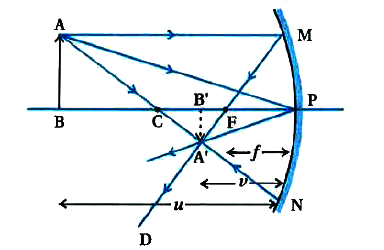Obtain mirror equation for the real image obtained by concave mirror. Solution in Gujrati

An object AB is perpendicular to principal axis away from C of a concave mirror.
AM ray from point A incidents on mirror at M and reflected ray passes through principal focus F.
AP ray from point A incidents on pole P and reflects back in form of PA.
These both reflected rays intersect at A., hence A. is real image of A.
A.B. is image of object AB due to reflection of rays from mirror.
Let FP = focal length f
CP = radius of curvature R
BP = object distance u
B.P= image distance v
For paraxial rays, MP can be considered to be a straight line perpendicular to CP.
The two right-angled triangles A.B.F and MPF are similar.
∴B.A.PM=B.FFP
But PM = BA
∴B.A.BA=B.FFP....(1)
Since ∠APB=∠A.PB., the right angled triangles A.B.P and ABP are also similar. Therefore,
∴B.A.BA=B.PBP ...(2)
Comparing Equations (1) and (2),
B.FFP=B.PBP
but B.F = B.P - FP
∴B.P−FPFP=B.PBP ....(3)
Now, according to sign convention, B.P = - v, FP = - f, BP = - u
From equation (3),
−v+f−f=−v−u
∴v−ff=vu
∴vf−1=vu
∴vf=1+vu
Now,dividing by v,
∴1f=1v+1u
Which is mirror equation and it is called Gaussian equation as it was given by scientist Gauss.
Topper's Solved these Questions
- RAY OPTICS AND OPTICAL INSTRUMENTSBOOK - KUMAR PRAKASHANCHAPTER - RAY OPTICS AND OPTICAL INSTRUMENTSEXERCISE - SECTION - A (TRY YOURSELF)
74 Videos
- RAY OPTICS AND OPTICAL INSTRUMENTSBOOK - KUMAR PRAKASHANCHAPTER - RAY OPTICS AND OPTICAL INSTRUMENTSEXERCISE - SECTION-B (NUMERICALS)(NUMERICAL FROM TEXTUAL ILLUSTRATIONS)
17 Videos
- MOVING CHARGES AND MAGNETISMBOOK - KUMAR PRAKASHANCHAPTER - MOVING CHARGES AND MAGNETISMEXERCISE - SECTION D (MCQs ASKED IN COMPETITIVE EXAMS)
34 Videos
- SAMPLE QUESTION PAPER BOOK - KUMAR PRAKASHANCHAPTER - SAMPLE QUESTION PAPER EXERCISE - PART-B SECTION-C
5 Videos
Similar Questions
Give range of wavelength of visible light.
View SolutionSuppose that the lower half of the concave mirror.s reflecting surface as shown in figure is covered with an opaque (non-reflective) material. What effect will this have on the image of an object placed in front of the mirror ?

View SolutionElectric charge Q having mass M moves on a circular path of radius R with velocity →v, perpendicular to uniform magnetic field B. When a particle completes one revolution, work done by the field is _______
View SolutionTwo charges –q and +q are located at points (0, 0, –a) and (0, 0, a), respectively.
(a) What is the electrostatic potential at the points (0, 0, z) and (x, y, 0) ?
(b) Obtain the dependence of potential on the distance r of a point from the origin when r/a>>1 .
(c) How much work is done in moving a small test charge from the point (5,0,0) to (–7,0,0) along the x-axis? Does the answer change if the path of the test charge between the same points is not along the x-axis?
View Solution____________ mirror is used for obtaining real images.
View Solutionअवतल दर्पण में वास्तविक प्रतिबिम्ब ___ बनता है।
View Solutionउत्तल दर्पण द्वारा वास्तविक प्रतिबिम्ब किस प्रकार प्राप्त किया जा सकता है ?
View SolutionWhich type of image cannot be obtained by concave mirror?
View SolutionWhich type of image cannot be obtained by a concave mirror?
View SolutionA real image of an object is to be obtained. The mirror required for this purpose is :
View SolutionDraw ray diagrams for the cases of images obtained in concave mirrors:
A ray diagram for object at infinity for a concave mirror.
View SolutionDraw ray diagrams for the cases of images obtained in concave mirrors:
A ray diagram for object beyond centre of curvature for a concave mirror.
View SolutionDraw ray diagrams for the cases of images obtained in concave mirrors: A ray diagram for object at the centre of curvature for a concave mirror.
View SolutionDraw ray diagrams for the cases of images obtained in concave mirrors:
A ray diagram for object between F and C for a concave mirror.
View SolutionDraw ray diagrams for the cases of images obtained in concave mirrors:
A ray diagram for object at focus for a concave mirror.
View Solution
